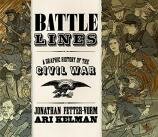Battle Lines: A Graphic History of the Civil War
Review
Battle Lines: A Graphic History of the Civil War
BATTLE LINES, by the combined effort of Jonathan Fetter-Vorm and Ari Kelman, takes the history of the Civil War and turns it into a story about people as well as politics. Each chapter focuses on a different person involved in the war, from Confederate and Union soldiers to Southern wives to freedmen to protesting Irishmen. It guides the reader through the entire history of the war from constantly shifting points of view, which forces a more or less unbiased opinion of what went on and how everyone reacted to the horrors around them.
The beginning of each chapter is formatted as a newspaper clipping, which gives context for the rest of the chapter. They move the book along, explaining the progression of the war almost the same way the chapter overview in a history textbook would. The rest of the chapter focuses on one person, or one group of people all in the same place at the same time, and tells a personal story that makes the history feel more real and alive. They go into the women in the South starving while the North enacts total warfare, the Irishmen who protest the draft and the men who try to fight them, the slaves who run away, and the soldier who misses his wife. What makes it feel even more real are the drawings themselves, which are painted in dulled colors the way an old tintype photograph would be, while still not totally black and white. It gives it more of a historical feel without distancing the reader from the event, and at the same time giving it an air of morbidity because of the muted color.
"BATTLE LINES takes what we learned in American history class and simultaneously simplifies it and digs deeper into the humanity (or lack thereof) in the war."
The only thing that could keep readers emotionally detached throughout BATTLE LINES is the wide scope it has. It covers the entire history of the Civil War, starting with Abraham Lincoln's election and ending with the reconstruction of the South and the election of Rutherford B. Hayes. This gives an overview of the Civil War so someone who may not fully understand it has the chance to do so, but it also means that it doesn't have a focus. It doesn't let the reader grow attached to or really learn about any character or point of view. That isn't necessarily a bad thing --- BATTLE LINES takes what we learned in American history class and simultaneously simplifies it and digs deeper into the humanity (or lack thereof) in the war. But that is how the book feels when reading it: like a more detailed, more simplified textbook.
The preface of the book says that there are about 65,000 books written on the Civil War. Every one of them has to have something that makes them stand out, that brings something new to the ideas of this war, or else they get lost in the sea of all the other books. What BATTLE LINES brings to the discussion is a way to digest something that is so complicated in a way that also makes it entertaining. BATTLE LINES does not give a deep understanding of any one person or point of view, but it gives a taste of almost every type of situation in the war, so readers can look back on it with unbiased sympathy and understanding.
Reviewed by Jess Costello on May 5, 2015
Battle Lines: A Graphic History of the Civil War
- Publication Date: May 5, 2015
- Genres: Graphic Novel
- Hardcover: 224 pages
- Publisher: Hill and Wang
- ISBN-10: 0809094746
- ISBN-13: 9780809094745









